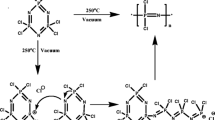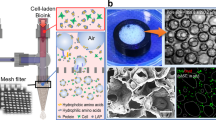Abstract
Trilayered polypyrrole (PPy) actuators have high stress density, low modulus and have wide potential biological applications including use in artificial muscles and in limb prosthesis after limb amputation. This article examines the in vivo biocompatibility of actuators in muscle using rabbit models. The actuators were specially designed with pores to encourage tissue in growth; this study also assessed the effect of such pores on the stability of the actuators in vivo. Trilayered PPy actuators were either laser cut with 150 µm pores or left pore-less and implanted into rabbit muscle for 3 days, 2 weeks, 4 weeks and 8 weeks and retrieved subsequently for histological analysis. In a second set of experiments, the cut edges of pores in porous actuator strips were further sealed by PPy after laser cutting to further improve its stability in vivo. Porous actuators with and without PPy sealing of pore edges were implanted intramuscularly for 4 and 8 weeks and assessed with histology. Pore-less actuators incited a mild inflammatory response, becoming progressively walled off by a thin layer of fibrous tissue. Porous actuators showed increased PPy fragmentation and delamination with associated greater foreign body response compared to pore-less actuators. The PPy fragmentation was minimized when the pore edges were sealed off by PPy after laser cutting showing less PPy debris. Laser cutting of the actuators with pores destabilizes the PPy. This can be overcome by sealing the cut edges of the pores with PPy after laser. The findings in this article have implications in future design and manufacturing of PPy actuator for use in vivo.
Graphical abstract








Similar content being viewed by others
References
Dillingham TR, Pezzin LE, MacKenzie EJ. Limb amputation and limb deficiency: epidemiology and recent trends in the United States. South Med J. 2002;95(8):875–83.
Schultz AE, Kuiken TA. Neural interfaces for control of upper limb prostheses: the state of the art and future possibilities. PM & R. 2011;3(1):55–67. http://doi.org/10.1016/j.pmrj.2010.06.016
Carey SL, Lura DJ, Highsmith MJ. Differences in myoelectric and body-powered upper-limb prostheses: systematic literature review. J Rehabil Res Dev. 2015;52(3):247–62. http://doi.org/10.1682/JRRD.2014.08.0192
Mirfakhrai T, Madden JDW, Baughman RH. Polymer artificial muscles. Mater Today. 2007;10(4):30–8. http://doi.org/10.1016/S1369-7021(07)70048-2
Hollerbach JM, Hunter IW, Ballantyne J. A comparative analysis of actuator technologies for robotics. In: Khatib O, Craig JJ, Lozano-Pérez T editors. The robotics review 2. Cambridge, MA, USA: MIT Press; 1992. p. 299–342.
Samatham R, Kim KJ, Dogruer D, Choi HR, Konyo M, Madden JD et al. Active Polymers: An Overview. In: Kim KJ, Tadokoro S editors. Electroactive Polymers for Robotic Applications Artificial Muscles and Sensors. 1st edn.: London: Springer-Verlag; 2007. p. 1–36.
Madden JD. Polypyrrole actuators: properties and initial applications. In: Kim KJ, Tadokoro S, editors. Electroactive Polymers for Robotic Applications: Artificial Muscles and Sensors. London. London: Springer; 2007. p. 121–52.
Madden JDW, Schmid B, Hechinger M, Lafontaine SR, Madden PGA, Hover FS, et al. Application of polypyrrole actuators: feasibility of variable camber foils. IEEE J Ocean Eng. 2004;29(3):738–49. http://doi.org/10.1109/joe.2004.833128
Madden JD, Cush RA, Kanigan TS, Hunter IW. Fast contracting polypyrrole actuators. Synth Metals. 2000;113(1–2):185–92. http://doi.org/10.1016/S0379-6779(00)00195-8
Hara S, Zama T, Takashima W, Kaneto K. Artificial muscles based on polypyrrole actuators with large strain and stress induced electrically. Polym J. 2004;36(2):151–61. http://doi.org/10.1295/polymj.36.151
Wu Y, Alici G, Spinks GM, Wallace GG. Fast trilayer polypyrrole bending actuators for high speed applications. Synth Metals. 2006;156(16–17):1017–22. http://doi.org/10.1016/j.synthmet.2006.06.022
John SW, Alici G, Cook CD. Inversion-based feedforward control of polypyrrole trilayer bender actuators. IEEE/ASME Trans Mechatron. 2010;15(1):149–56. http://doi.org/10.1109/tmech.2009.2020732
Kiefer R, Mandviwalla X, Archer R, Tjahyono SS, Wang H, MacDonald B et al., editors. The application of polypyrrole trilayer actuators in microfluidics and robotics2008
Cui X, Wiler J, Dzaman M, Altschuler RA, Martin DC. In vivo studies of polypyrrole/peptide coated neural probes. Biomaterials. 2003;24(5):777–87
Cui X, Lee VA, Raphael Y, Wiler JA, Hetke JF, Anderson DJ, et al. Surface modification of neural recording electrodes with conducting polymer/biomolecule blends. J Biomed Mater Res. 2001;56(2):261–72.
Stauffer WR, Cui XT. Polypyrrole doped with 2 peptide sequences from laminin. Biomaterials. 2006;27(11):2405–13. http://doi.org/10.1016/j.biomaterials.2005.10.024
Meng S, Rouabhia M, Shi G, Zhang Z. Heparin dopant increases the electrical stability, cell adhesion, and growth of conducting polypyrrole/poly(L,L-lactide) composites. J Biomed Mater Res A. 2008;87(2):332–44. http://doi.org/10.1002/jbm.a.31735
Stewart E, Kobayashi NR, Higgins MJ, Quigley AF, Jamali S, Moulton SE, et al. Electrical stimulation using conductive polymer polypyrrole promotes differentiation of human neural stem cells: a biocompatible platform for translational neural tissue engineering. Tissue Eng C, Methods. 2015;21(4):385–93. http://doi.org/10.1089/ten.TEC.2014.0338
Thompson BC, Moulton SE, Ding J, Richardson R, Cameron A, O’Leary S, et al. Optimising the incorporation and release of a neurotrophic factor using conducting polypyrrole. J Controlled Release. 2006;116(3):285–94. http://doi.org/10.1016/j.jconrel.2006.09.004
Kim D-H, Martin DC. Sustained release of dexamethasone from hydrophilic matrices using PLGA nanoparticles for neural drug delivery. Biomaterials. 2006;27(15):3031–7. http://doi.org/10.1016/j.biomaterials.2005.12.021
Wang Z, Roberge C, Dao LH, Wan Y, Shi G, Rouabhia M, et al. In vivo evaluation of a novel electrically conductive polypyrrole/poly(D,L-lactide) composite and polypyrrole-coated poly(D,L-lactide-co-glycolide) membranes. J Biomed Mater Res A. 2004;70(1):28–38. http://doi.org/10.1002/jbm.a.30047
Schmidt CE, Shastri VR, Vacanti JP, Langer R. Stimulation of neurite outgrowth using an electrically conducting polymer. Proc Natl Acad Sci. 1997;94(17):8948-53
George PM, Lyckman AW, LaVan DA, Hegde A, Leung Y, Avasare R, et al. Fabrication and biocompatibility of polypyrrole implants suitable for neural prosthetics. Biomaterials. 2005;26(17):3511–9. http://doi.org/10.1016/j.biomaterials.2004.09.037
Wang X, Gu X, Yuan C, Chen S, Zhang P, Zhang T, et al. Evaluation of biocompatibility of polypyrrole in vitro and in vivo. J Biomed Mater Res Part A. 2004;68(3):411–22. http://doi.org/10.1002/jbm.a.20065
Richardson RT, Wise AK, Thompson BC, Flynn BO, Atkinson PJ, Fretwell NJ, et al. Polypyrrole-coated electrodes for the delivery of charge and neurotrophins to cochlear neurons. Biomaterials. 2009;30(13):2614–24. http://doi.org/10.1016/j.biomaterials.2009.01.015
Jiang X, Marois Y, Traore A, Tessier D, Dao LH, Guidoin R, et al. Tissue reaction to polypyrrole-coated polyester fabrics: an in vivo study in rats. Tissue Eng. 2002;8(4):635–47. http://doi.org/10.1089/107632702760240553
Wadhwa R, Lagenaur CF, Cui XT. Electrochemically controlled release of dexamethasone from conducting polymer polypyrrole coated electrode. J Controlled Release. 2006;110(3):531–41. http://doi.org/10.1016/j.jconrel.2005.10.027
Thompson BC, Moulton SE, Ding J, Richardson R, Cameron A, O’Leary S, et al. Optimising the incorporation and release of a neurotrophic factor using conducting polypyrrole. J Controlled Release. 2006;116(3):285–94. http://doi.org/10.1016/j.jconrel.2006.09.004
Schlenoff JB, Xu H. Evolution of physical and electrochemical properties of polypyrrole during extended oxidation. J Electrochemical Soc. 1992;139(9):2397–401. http://doi.org/10.1149/1.2221238
Pfluger P, Street GB. Chemical, electronic, and structural properties of conducting heterocyclic polymers: a view by XPS. J Chemical Phys. 1984;80(1):544–53. http://doi.org/10.1063/1.446428
Cui XT, Zhou DD. Poly (3,4-ethylenedioxythiophene) for chronic neural stimulation. IEEE Trans Neural Syst Rehabil Eng 2007;15(4):502–8. http://doi.org/10.1109/TNSRE.2007.909811
Acknowledgements
This work was funded through the Australian Orthopaedic Association (AOA) research foundation grant. The authors would like to acknowledge the Australian National Fabrication Facility (ANFF) Materials Node at Wollongong for use of their facilities
Author information
Authors and Affiliations
Corresponding author
Ethics declarations
Conflict of interest
The authors declare that they have no competing interests.
Rights and permissions
About this article
Cite this article
Zhang, B.G.X., Spinks, G.M., Gorkin, R. et al. In vivo biocompatibility of porous and non-porous polypyrrole based trilayered actuators. J Mater Sci: Mater Med 28, 172 (2017). https://doi.org/10.1007/s10856-017-5979-3
Received:
Accepted:
Published:
DOI: https://doi.org/10.1007/s10856-017-5979-3




